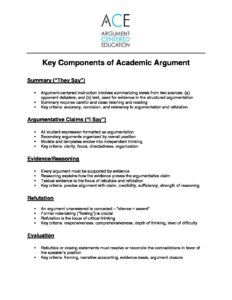
A Simple Argumentation Activity on the UN ‘Declaration of the Rights of the Child’ (1959)
One of our partner schools is in the midst of a unit on the challenges of childhood in their English language arts classes. One of the readings they are discussing is the 1959 United Nations Declaration of the Rights of the Child, which lays out an elaboration and further definition of the UN’s foundational Universal Declaration of Human Rights (1948) line that reads:
Motherhood and childhood are entitled to special care and assistance.
 The lead ELA teacher in this collaboration wanted to do something more limited in scope and duration than a fully developed classroom debating, structured argumentation, or argument writing project, so we designed a simple argumentation activity that draws on several of the key components of academic argument that form the core of Argument-Centered Education’s pedagogical approach.
The lead ELA teacher in this collaboration wanted to do something more limited in scope and duration than a fully developed classroom debating, structured argumentation, or argument writing project, so we designed a simple argumentation activity that draws on several of the key components of academic argument that form the core of Argument-Centered Education’s pedagogical approach.

The activity first asks students to summarize the five most important rights conferred by the 1959 United Nations Declaration. It uses a sentence starter to help students practice full-sentence formulation of these short summaries.
It next asks students to identify the right that they believe is most fundamental to the protection of children. Students are then to make two arguments, again with the support of a template, for why the right they selected is most important. These arguments should be distinct from each other, and they should be supported by whatever backing the students can generate from readings and discussion they have done throughout the unit. The term “backing” is used deliberately here, in place of the more formal “evidence and reasoning,” since students are given wider latitude in this activity to adduce what support they can. Where there is not substantial content instruction on an area of argument — as in this unit, there will have been little discussion preceding about the various principles and protections in the UN Declaration — backing is a properly looser substitute for support of a claim. Students can reason through their own experience, and their own acquired knowledge, to support their claims, without having to produce objective, cited evidence that they they apply analytic reasoning to explain.
Finally, the activity asks students to think critically about what someone might identify as the most serious limitation of the force of the United Nations Declaration in defending and protecting children around the world, and how they would respond to this point. This portion of the activity exercises students refutation skills and the critical thinking they are integral to.

This activity is designed to be finished within a single 50 minute class period, including about 15 minutes to read the Declaration itself. An optional second class period could be devoted to having small groups or pairs share and discuss their responses and then share out in a larger classroom showcasing of some exemplary student work.
Argument-centered instruction, as this activity demonstrates, encompasses small-scale academic modules, in addition to larger and more comprehensive projects and assessments.

